This is a guest post by one of our most inspiring customers, Mark Hansen, who is a co-founder of Upsolve and an early member of Segment’s Startup Program. He shares his story of turning his fledgling bankruptcy non-profit into a data-backed organization built to scale.
“I’m too broke to file for bankruptcy,” is a phrase that should never be said. Yet nearly 20 million Americans every year find themselves in this position. Our organization Upsolve is on a mission is to help low-income Americans in financial distress file Chapter 7 bankruptcy at no cost. We do this by combining the power of technology with attorneys. Up through March 2019, we’ve helped hundreds of families clear over $37,000,000 of debt. But there are 20 million more that could use our help.
In this article, I’ll share the story of our organization’s Y Combinator W19 experience and how we found a pathway to scale our nonprofit. With Segment’s advice early on, we went from running a few SQL queries a month to analyzing user behavior and reacting to it within the same day. As the solo designer and developer for Upsolve, I thought being data-driven was a luxury. I hope this shows you that no matter how small you are, it’s an absolute necessity.
I hope our story brings ideas and lessons to you as you carry on in your own journey!
I use the term radical in its original meaning—getting down to and understanding the root cause. It means facing a system that does not lend itself to your needs and devising means by which you change that system. That is easier said than done. But one of the things that has to be faced is, in the process of wanting to change that system, how much have we got to do to find out who we are, where we have come from and where we are going....
— Ella Baker
Bankruptcy: A social safety net out of reach
Upsolve is a tech nonprofit that helps low-income families file bankruptcy for free. Bankruptcy is a tool that is often sought out by businesses, but individuals can declare bankruptcy, too! Declaring bankruptcy is often the social safety net of last resort when other systems have failed, allowing individuals to completely clear away any debts that they have except student loans.
For decades, poverty in the United States has been associated with social stigmas. Unfortunately, the reasons why people find themselves in financial trouble are often outside their control. Falling into financial ruin can happen to anyone, no matter the age, demographic, or education. The most common reasons people turn to bankruptcy are because of job loss, medical emergencies, predatory loans, and divorce. Those who are unable to take advantage of bankruptcy are at a high risk of falling into the cycle of poverty, homelessness, and going hungry. It’s also been proven they will have a shorter life expectancy by several years.
Despite the critical benefits of bankruptcy, only 2% of people who could benefit from filing for bankruptcy actually make it through this process. That’s because people imagine bankruptcy requires a lawyer, which can cost more than $1,000. If you have $30 in your pocket, and you’re living out of your car, this is not an option. But when you’re served a letter saying you will be sued if you don’t pay your debts, filing on your own becomes the only option.
Doing this process by yourself is intimidating. The first challenge is figuring out whether Chapter 7 bankruptcy makes sense, which forms are relevant, and how to fill them out correctly. The second challenge is to find the money and a working debit card to pay for two required online courses. The third is printing out hundreds of pages of documents, which is another big cost and time sink and might require traveling to find a printer. Finally, you’re expected to find time during a work week to make a multi-hour drive to the closest court. If you don’t have a car, you must coordinate borrowing one or getting a ride from a friend or public transportation. If you have kids, you must coordinate having someone take care of them.
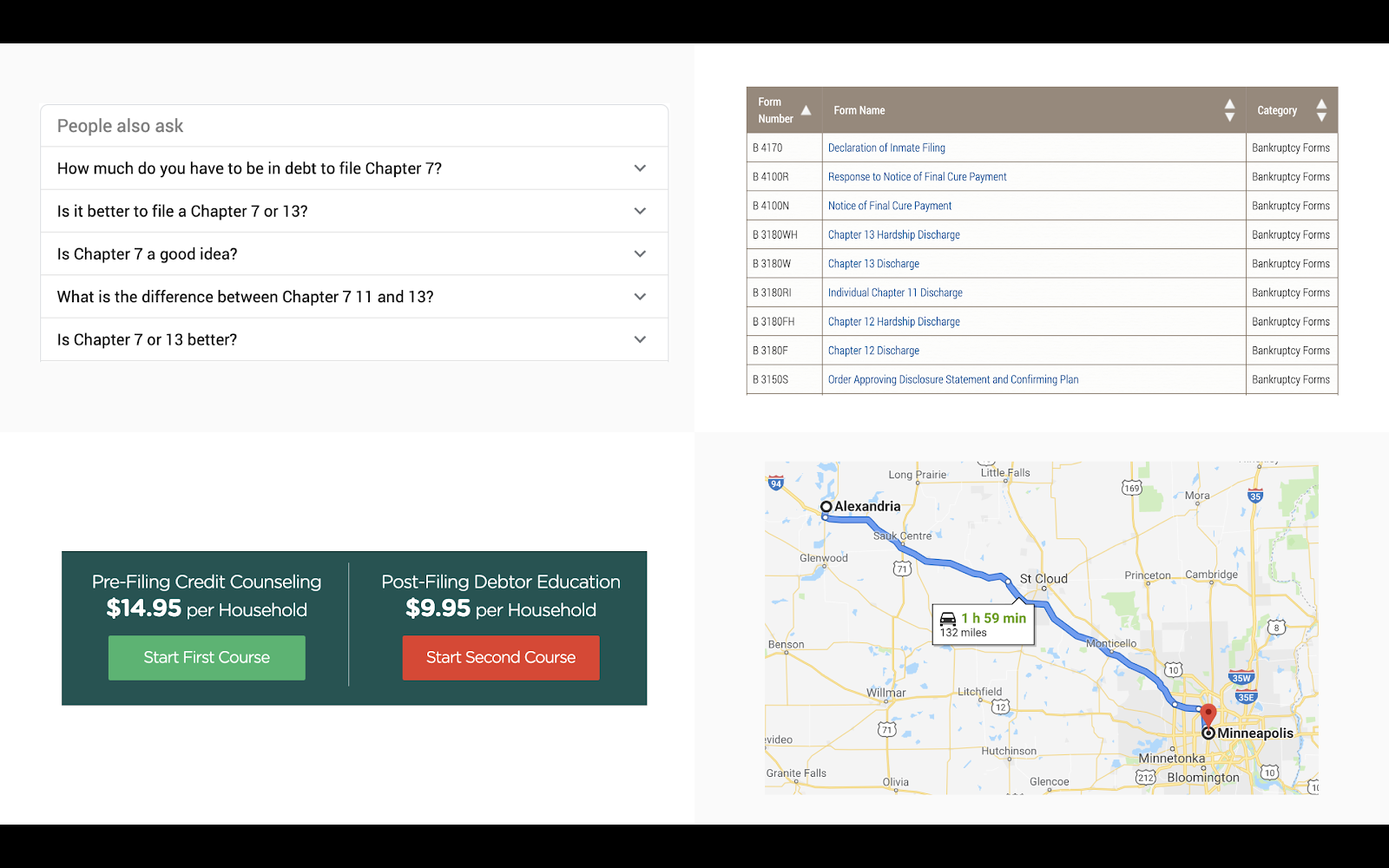
In other words, good luck and pray you didn’t make errors. If you do have errors, the three most likely things to occur are:
-
Your case is dismissed and closed, meaning you wasted an incredible amount of time and several hundred dollars (which you likely borrowed).
-
You’re asked to make corrections, dragging out the process several more weeks.
-
You receive a discharge, but when listing assets you incorrectly assigned exemption laws so some of your assets are seized.
Exemption laws are state by state guidelines for what assets can and cannot be taken. To give an example of the complexity: a person in Missouri trying to protect their wedding ring has to understand exemption law Mo. Rev. Stat. § 513.430 1.(2), exemption law Mo. Rev. Stat. § 513.430 1.(3), and possibly federal exemption law 11 U.S.C. § 522(d)(4), all of which have their own caveats and limits for protecting assets.
This has to be done with every asset a person owns from clothes, to cars, to retirement funds. Mislabel one and you can potentially lose it.
What might a different future look like?
If the bankruptcy code is made up of a bunch of rules, couldn’t software make this easier? Couldn’t software tell you if you’re a good fit? Couldn’t software just tell you what forms are relevant? Couldn’t software automatically get your course and court fees waived? Couldn’t software tell you about relevant updates so you didn’t have to check the mail?
Yes, it can! And that’s what we did to give people back their access to this important social safety net. Up through March 2019, we’ve cleared $37,000,000+ of debt for hundreds of families.
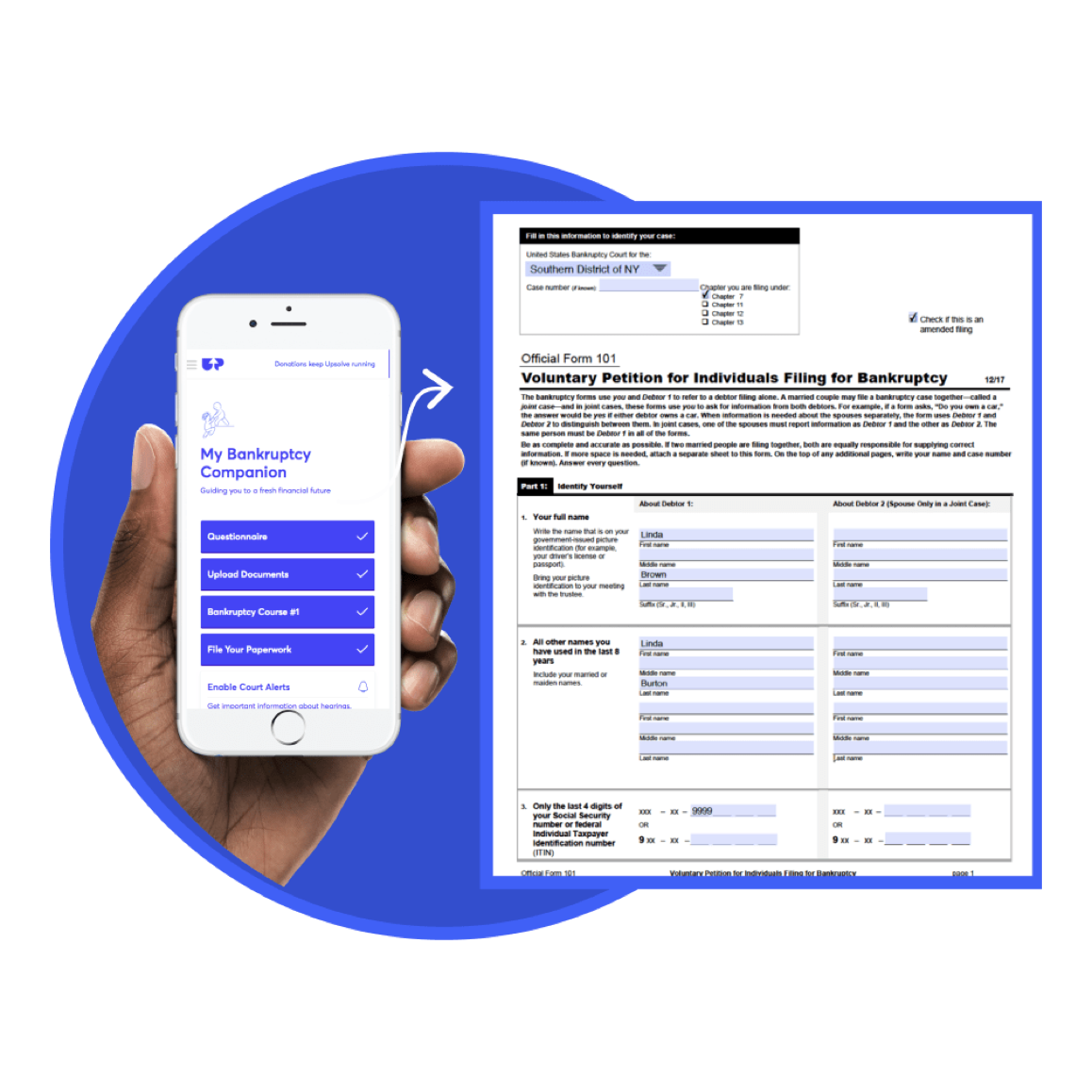
The path to this future wasn’t clear
In December, we only had received $559 in donations from users who filed as a thank you, and the grant money in our bank accounts would only get us 9 more months down the line. We really didn’t want to see the headline: “Poverty fighting nonprofit shuts its doors.”
Additionally, to help every person who could benefit from Chapter 7 would cost millions ($5 fixed cost per case times the 20 million people in the United States who could benefit from filing for bankruptcy). No foundation could support that sort of cost in the long run.
As we grappled with how we could give 20 million families access to bankruptcy, we looked to a place where growth and scale was the absolute goal. Enter, Y Combinator. We took a leap of faith to put in our application, and before we knew it we sat in a room with the YC batch. The expectation: A nonprofit should be as effective and ambitious as all the other organizations they took in.
YC’s challenge— Become sustainable
Y Combinator was a tough environment, not because we had to work harder, but because all our norms would be challenged. As much as we loved to create a better and better product to help people through bankruptcy, the financial self-sustainability of the organization needed attention. Our second week, the partners drove it home for us with a startling request:
Partners: Become break-even by demo day.
Us: But regulations don’t allow us to sell the service, our users have no money and deserve it for free, volume is so low …
Partners: Airbnb did it. Can you earn $500 by next group office hours?
Us: *Pause*…Yes
The phone call ended, and we just started firing off ideas. We knew we couldn’t finish enough cases by office hours to get more than $500 in donations.
Flying blind on the path to growth
Before even considering revenue, we were focused on how we could do 10% more case filings each week. SEO-minded content was the strategy, but we couldn’t really tell how well or poorly we were doing. The only indicator we had was the number of accounts created. We didn't know how to setup and measure our goals, and we didn't know how many people were dropping off in the funnel or where! We needed to get these stats to know where to spend time improving the product if we wanted to have any chance meeting expectations for the next group office hours.
With all the other fires raging, measuring the flow of our product was getting the back burner. I had given teammates BI tools and SQL queries, but they were still uncomfortable with self-research. We had a volunteer try to centralize BI and logs by transitioning us to the ELK stack (ElasticSearch, Logstash, Kibana) but it was breaking down almost daily and they had disappeared.
I felt like I was floundering. It felt like we were all flying blind, and my increasingly crazy looking SQL queries were all that gave us insight into what was happening. When deciding which office hours we should go to the day of YC’s growth workshop, we clearly knew we needed guidance with our analytics.
“Stop doing that!”
As a nonprofit, we were trying to save every penny we could. With AWS credits out the wazoo and knowing that big tech companies ran ELK stacks, it seemed worthwhile to invest in the future proof solution. But it’s hard when you’re the only dev to evaluate when your time spent is far greater than some other alternative.
That Saturday, my team and I decided to attend the YC Growth Bootcamp. We were excited by a lot of the sessions, and I was especially amped to learn about analytics. Segment’s co-founder Ilya Volodarksy gave a presentation that helped us understand what was possible if we understood our customers, and how a certain set of tools and practices would continue to work if we scaled. I still remember the slide showing goal tracking and the behavior flows in Google Analytics and being amazed that was a feature. Afterwards, we were able to sign up for an analytics office hours session with Ilya, and dig deep into our stack. It was clear it was time to ditch the ELK stack.
A few hundred dollars on helpful tools could be the difference of a growing or failing business, and if we couldn’t pay for these tools, we had bigger problems. It made sense to go all in and invest for YC. Ilya gave us a set of recommendations we implemented that weekend, and we were off! My co-founders weren’t distracting me with complex questions I need to write custom SQL queries for, we finally had visibility into behavior of our users and parts of the funnel we were blind to, and we had peace of mind that the tools in place were all we’d need to get to the next level.

Ready to go!
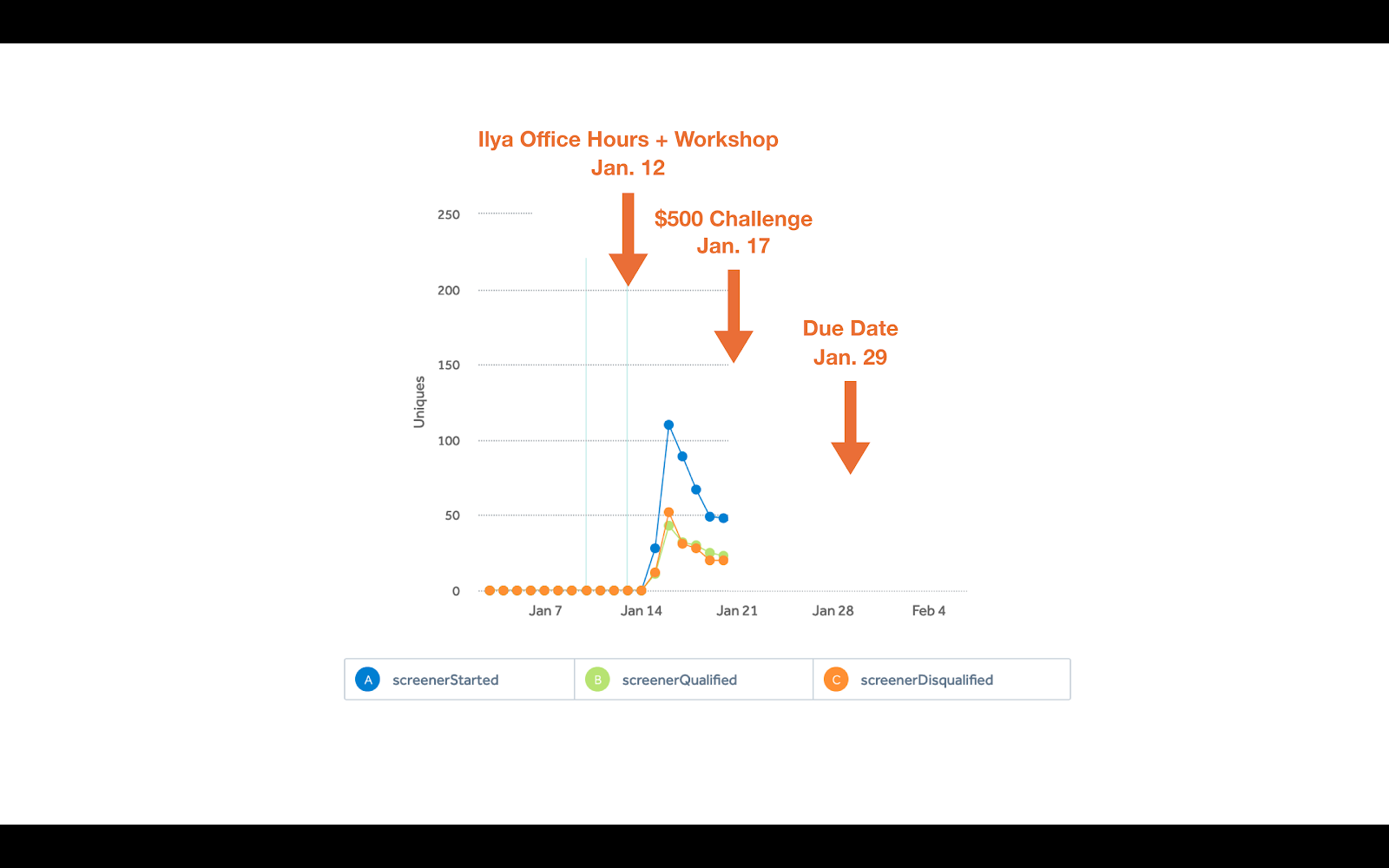
Data/analytics stack before the bootcamp:
Only I can access: ELK Stack (broke every day), Google Analytics (Misconfigured), Postico (PSQL client)
Stack after the bootcamp
Teamwide access: Amplitude, ChartIO, CustomerIO, Fullstory, Google Analytics, Google Search Console, Segment
Stack we use today today:
Teamwide access: Amplitude, ChartIO, CustomerIO, Fullstory, Google Analytics, Google Search Console, Segment
12 Days, $500 Left — Business Model #1
The first and obvious way to earn $500 was improve our donation flow. For every person we helped, it cost us $5, so helping all 20 million would require $100,000,000. We had been asking users to donate after we’ve helped them file because we do not charge people for our service. This is called a “Donate What’s Fair” model.
The three levers we had for trying to move this 10X were to increase how many people filed bankruptcy, increase how much we asked for, and change where in our flow we asked for a donation.
With 12 days to make $500, we couldn’t get 10x people to the filing step. We finally had visibility into our product funnel and all drop off happened in the information collection phase, which was necessary and could only be marginally improved.
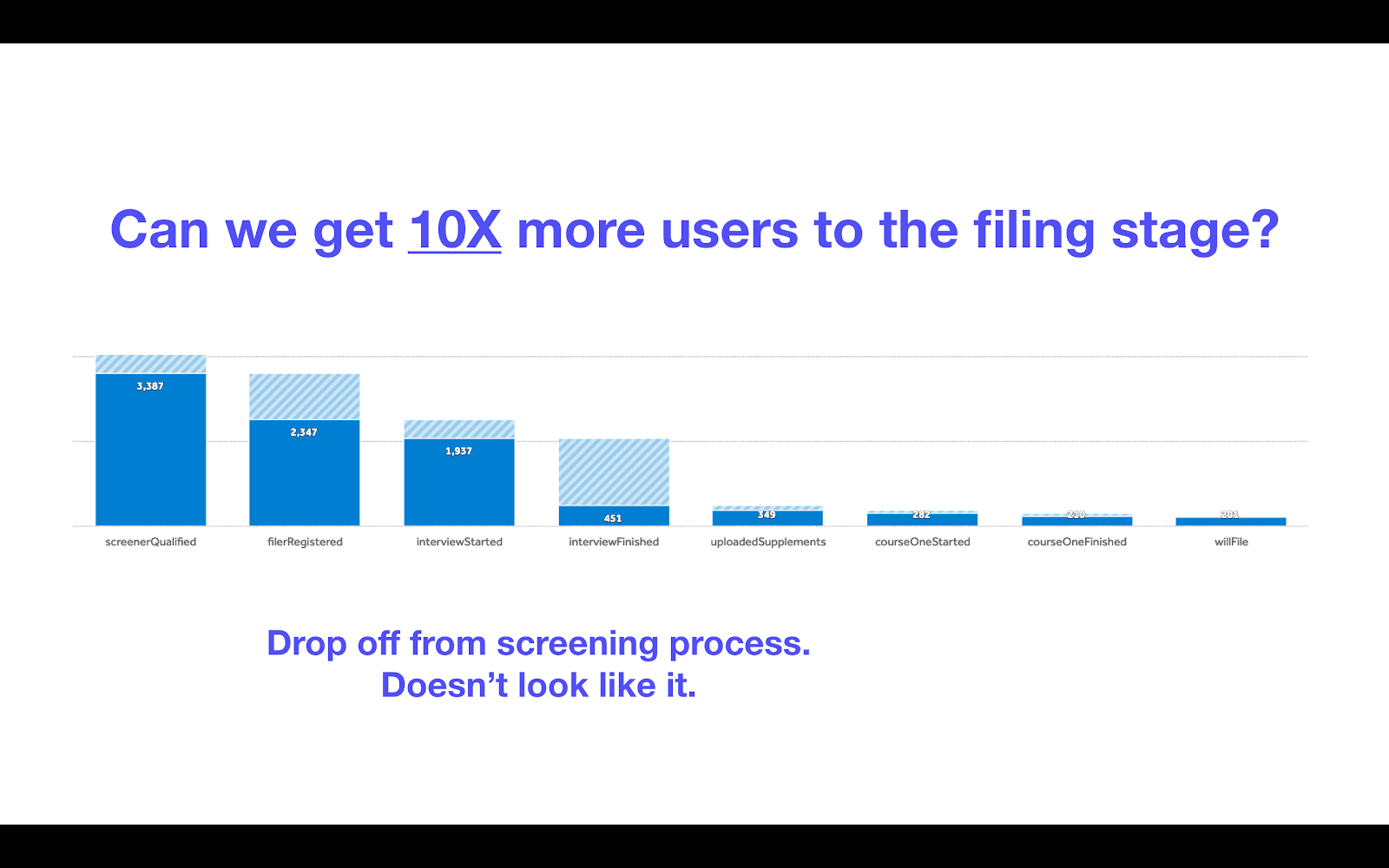
So we looked at how we could increase the amount given per user by changing the design in two ways: 1) ask for a donation when giving users paperwork, the moment our users experience the greatest value and 2) be more explicit about our costs helping people and show future impact. With these modifications, we were seeing above $5 in donation revenue per user. Here were two iterations.
V2 - Increase Visibility
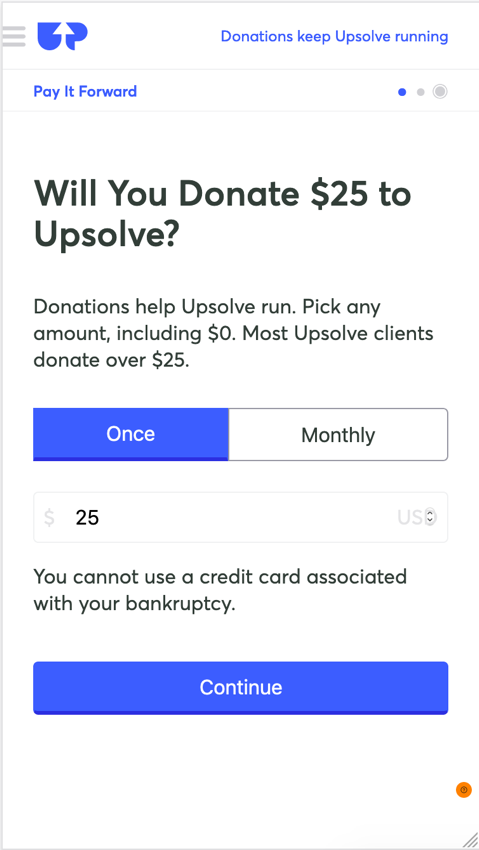
V3 - Explain Where The Money Goes
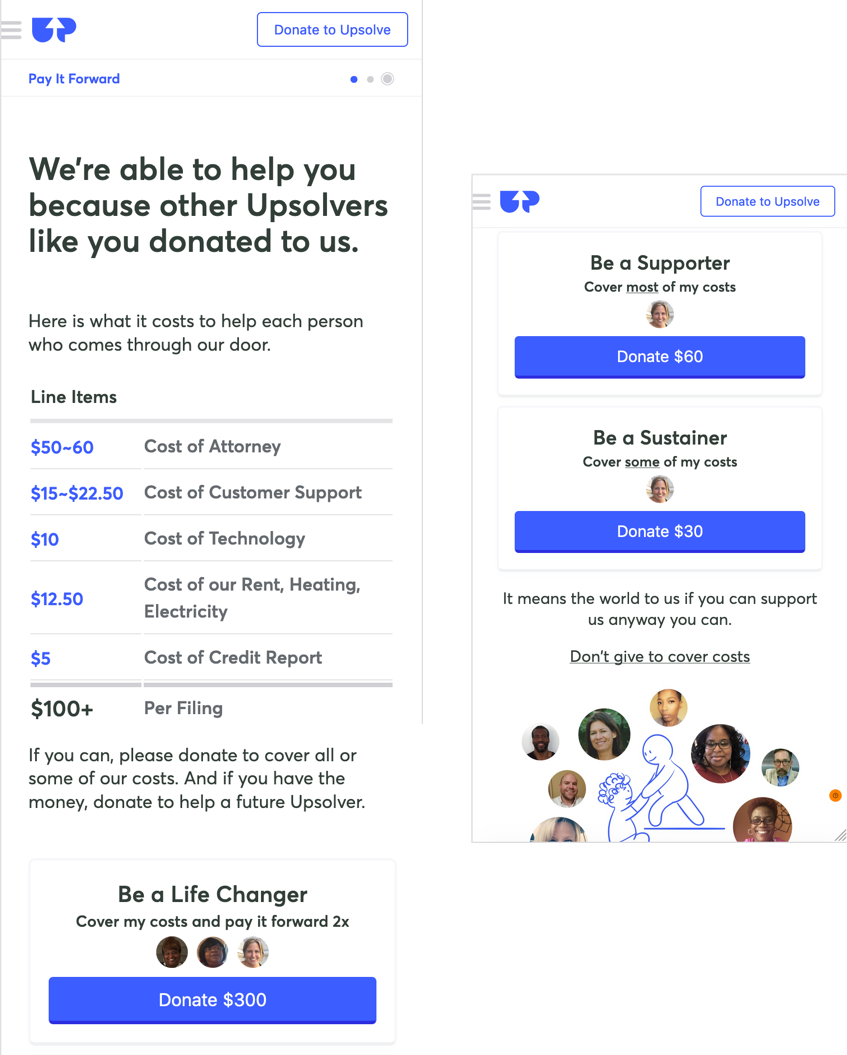
We were amazed that this worked. We now broke even with every case we did, making it feasible for us in the long run to help millions of families! But with that small a margin, we had to do 360,000 cases in the next 9 months to survive and by this point we did 400. We still only had 9 months to live.
6 Days, $164 left — Business model #2
Up until this point we had received $136 in donations and another $200 from revenue experiments Rohan and Jonathan had done that in the end that cost more than they were worth. With 6 days left, things weren’t looking good.
In between meetings, writing code, going to events, etc. we had our metrics tab up.
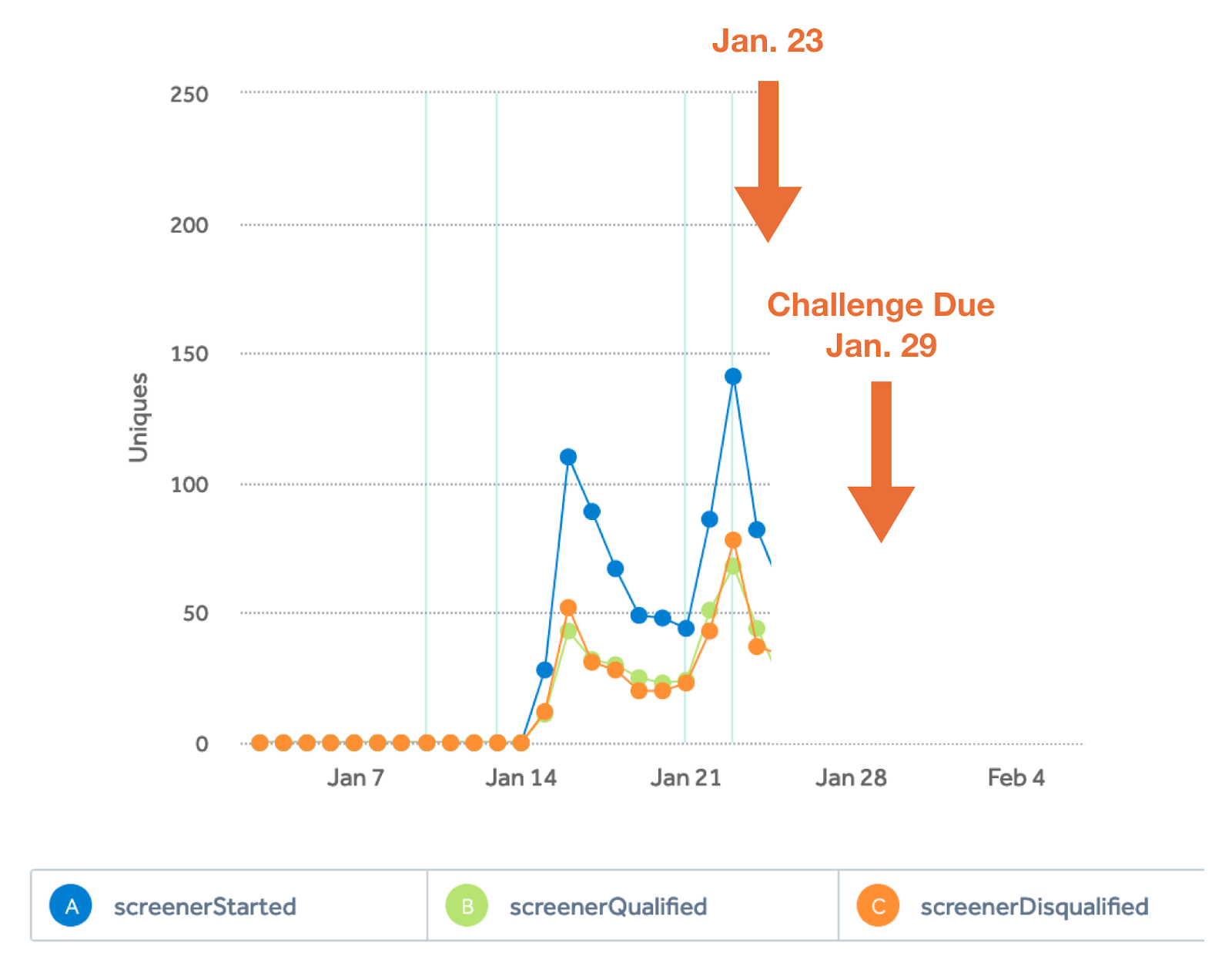
We were marinating in the numbers over the days when Rohan had a realization that would change the trajectory of Upsolve forever. That orange line represented dozens of people who were coming to our service that we couldn’t help, and attorneys were spending a ton of money trying to acquire users on Google ads to just get users to their website. Would our high-income visitors to Upsolve prefer we put them in touch with an attorney? Would the attorneys be willing to pay for that introduction? With a few phone calls, spreadsheets, and experiments we realized both were a yes, and we partnered with Legal Zoom.
$500 and a path to long-term impact
At first, we just printed phone numbers from the screener to our Slack and gave folks a call to validate interest. Then we put a button that didn’t do anything just to see if people would click it and called up attorneys ourselves to match with people who clicked. Click rates were incredibly high with our warm and trusting copy, showing us there was some promise.
When we formalized an agreement with a third-party, they gave us a phone number which if users called, would lead to double the referral revenue for us. Making this CTA a “call 1-800...” and seeing it drop to a 2% conversion rate made us really internalize just how toxic phone numbers were to our community. So much so we removed the phone number question from our screener for qualified user sign ups.
After a few more iterations, we came to an onboarding flow that provided meaningful conversion. The conversion numbers showed us that all we needed was to 2-3x website traffic and we could become self-sustainable.
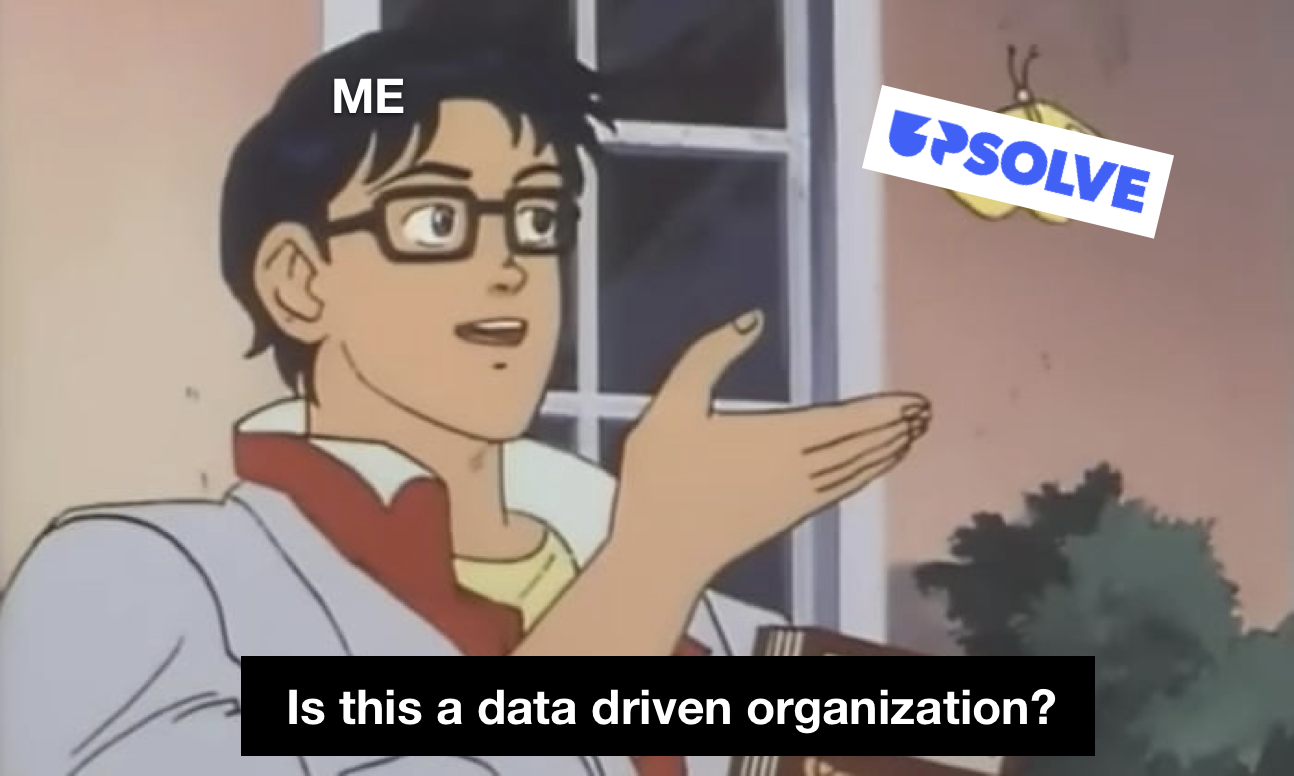
By the time of group office hours, we not only were able to meet a goal we thought was wild a week earlier, but we had a formula for becoming a self-sustaining non-profit. The partners and everyone in our group gave us an applause and were excited to see us to get self-sustainability.
What is this feeling?
This was becoming a weird transition moment. Up until this point, I had placed all my actions through the lens of making something people love. Now we are able to place our work with a surrounding formula that delivered on both revenue and impact. Was this what it feels like when you have “product market fit”? I guess so.
When data and charts were available constantly to everyone, I felt we started to act differently. With the driving goal so clear, we were able to operate more efficiently and autonomously. With this data washing over us so often, we also started to understand our users in non-obvious ways.
But the biggest change in my mind was how we started to evaluate each others’ priorities against our own. Now, we judge how our priorities align with organizational goals. Second, we compare our own needs against others in a much clearer way. We all felt the pains of growth, but when we began to see a big uptick in sign-ups, we knew Tina was going to getting hit hard with reviews. We all could quickly identify and agree upon where our limited development time needed to be spent.
$500 cleared! All hands on deck for top of funnel!
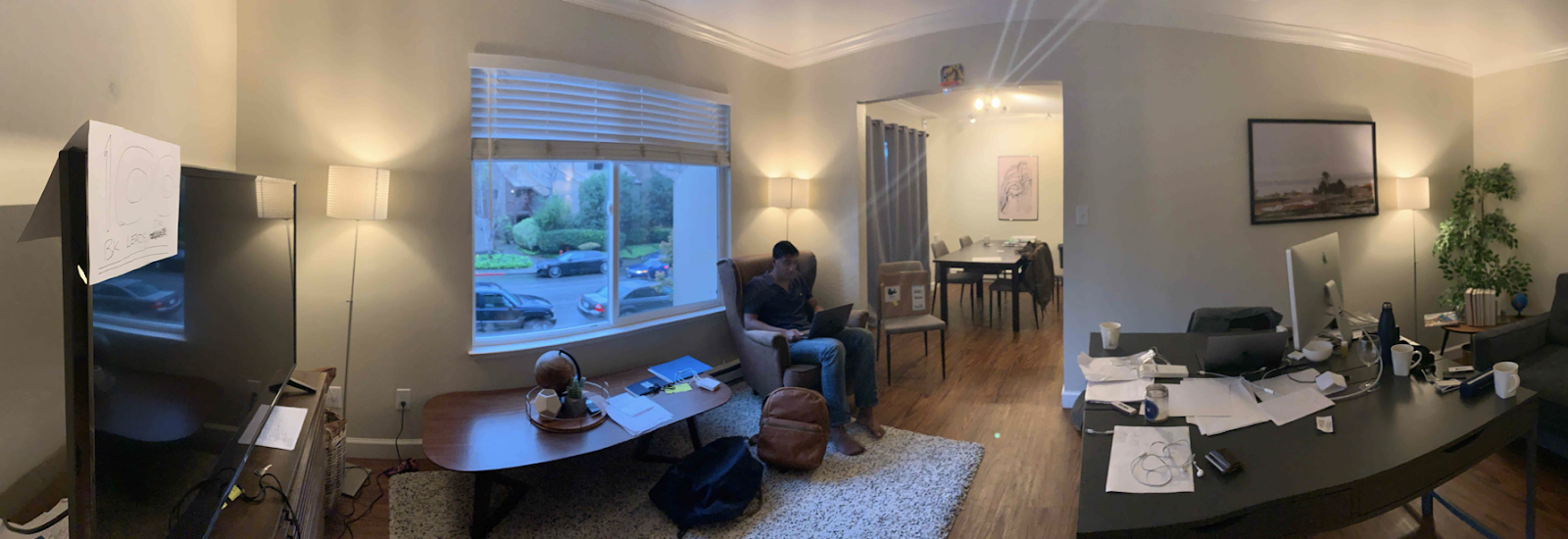
With success hitting our $500 challenge, we looked outwards with our new formula in hand and a real challenge to ourselves to become financially self-sustaining by the end of YC. The feedback from the partners at this point was to move on to top of the funnel. The conversion rate was great and for the amount of work we were putting in, it didn’t seem like a 10x possibility was possible in conversions.
With SEO as the strategy, we want on a feature building spree.
We restructured our website to be locality based and improved internal linking.
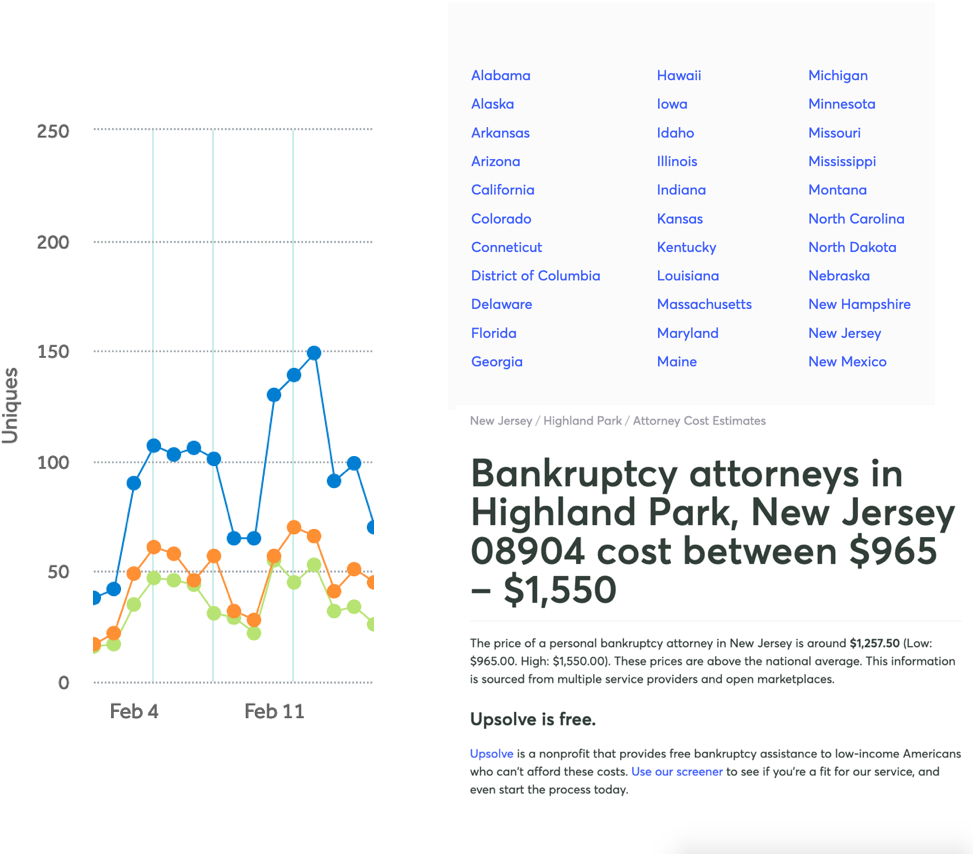
Then we placed CTAs everywhere.
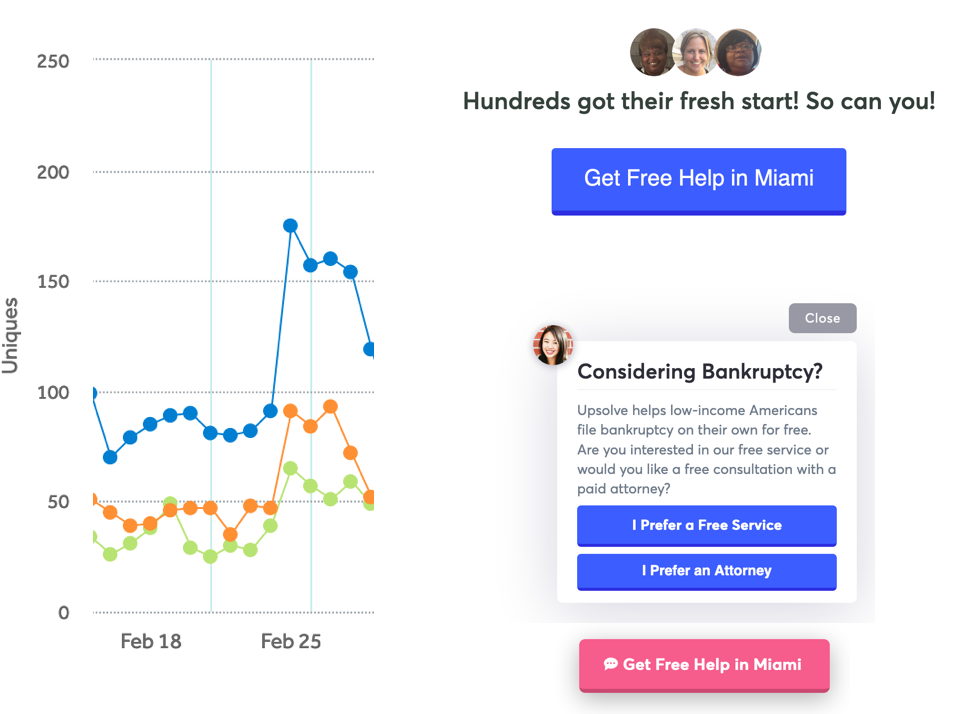
Then we boosted our page speed and more until we started to see diminishing returns to our programmatic and technical SEO efforts, and finally a bit of impact from an algorithmic change focused on financial information websites.
YC in Data
While words are great, nothing summarizes our work better than two charts.
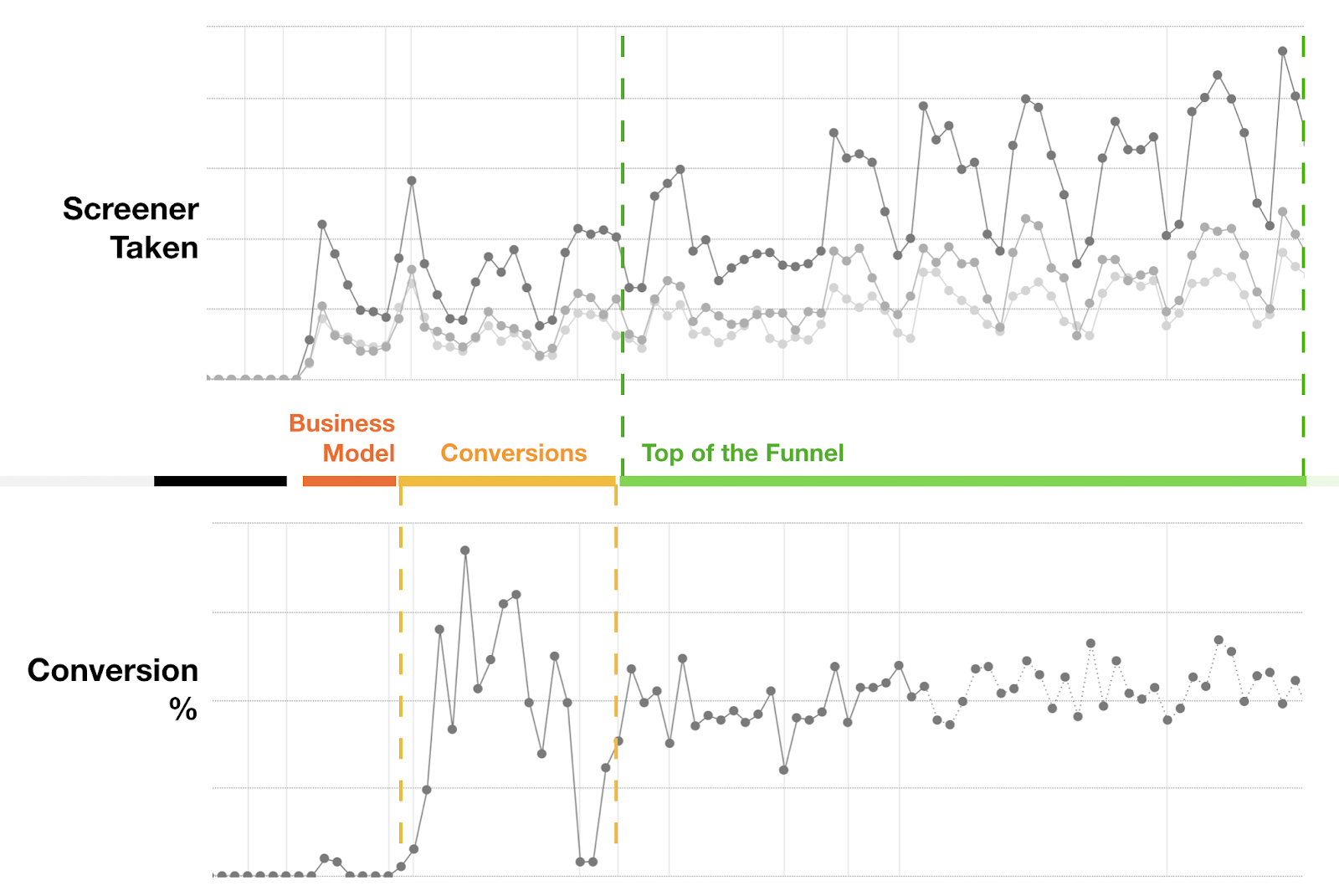
It’s clear to see how we went from getting data in, to finding a business model, to improving conversions, and finally add in top of the funnel. The result was 60% self-sustainability by demo day of W19.
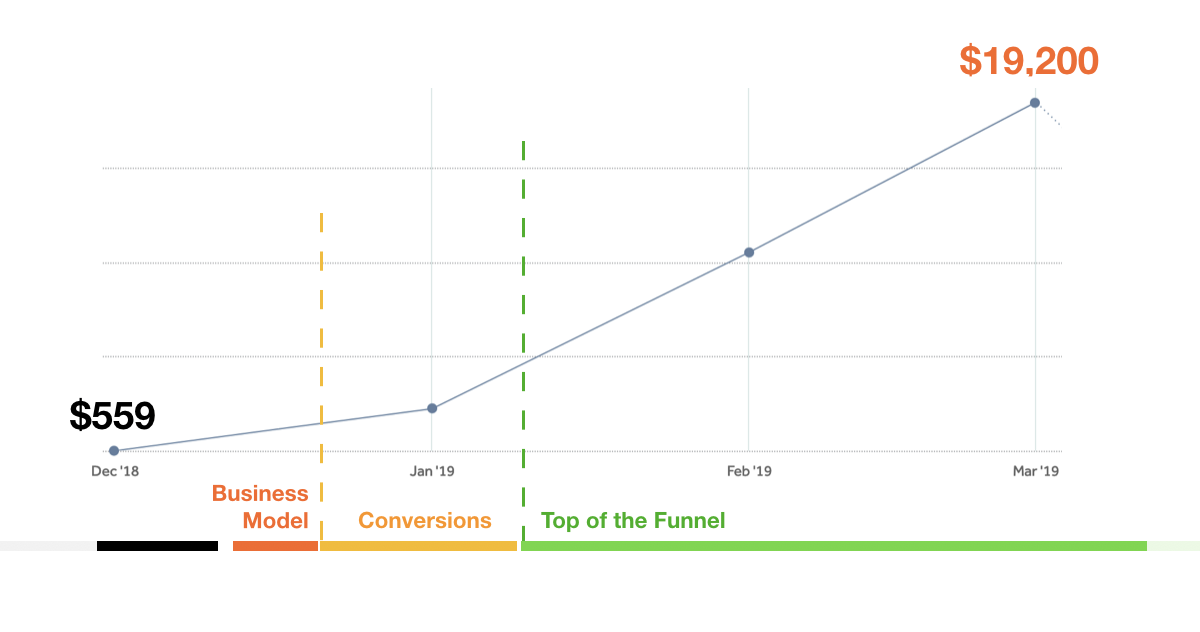
How we change
This experience felt like something Lewis and Clark would have gone through. In getting to the coast, they had to constantly evaluate where they were and how to go forward. You can only see so far, so you can only just choose the best path from where you are.
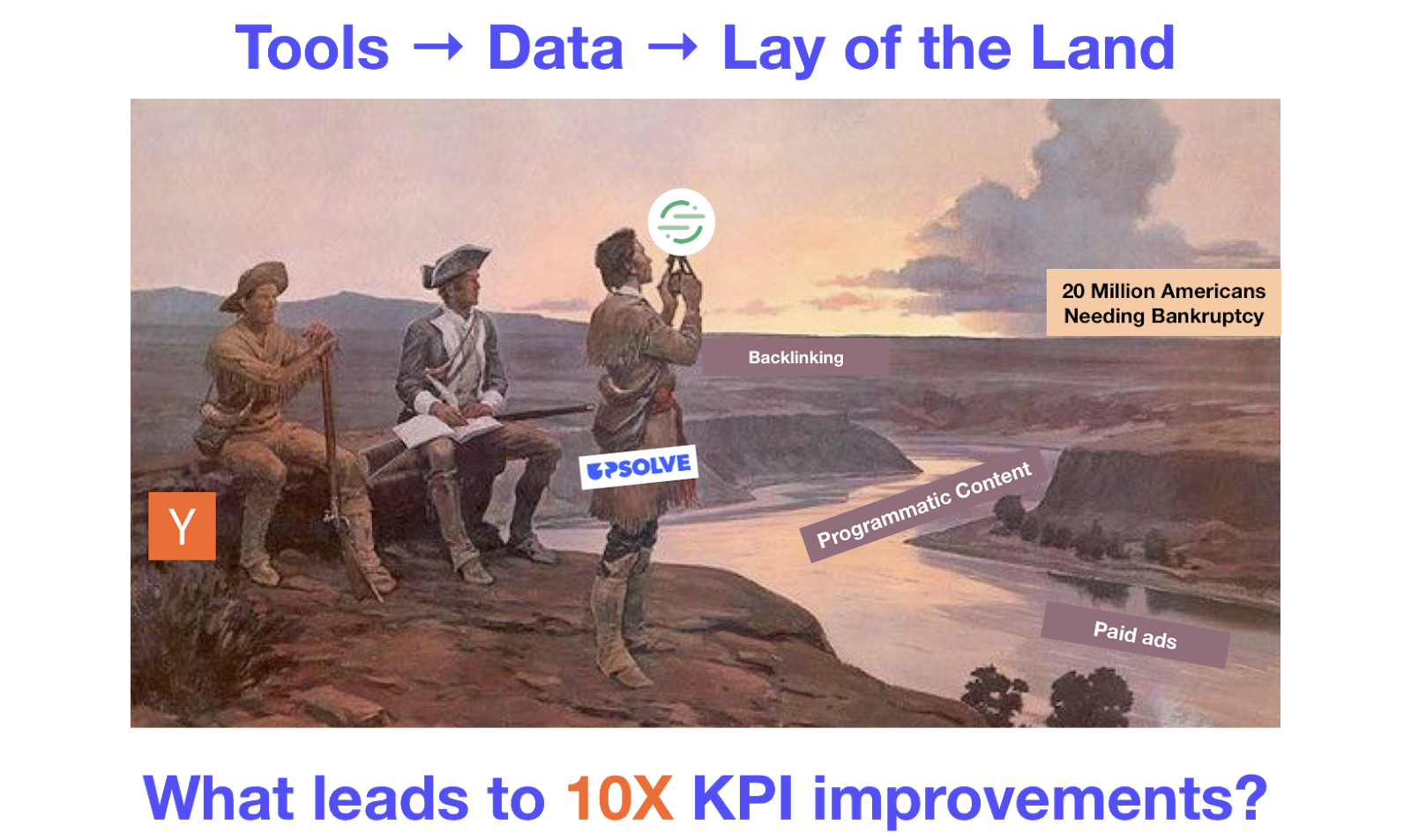
Segment was our version of Lewis & Clark’s celestial navigation tools. The ease of use and data it provided allowed us to evaluate our paths forward, helping us see where the 10x opportunity could lie. We weren’t optimizing our product, we were finding ways to push ourselves to meet the challenge of helping millions of families in America.
Thank you!
Thank you for reading. Our journey has many peaks and valleys, but the past few months were a very special for us, and there were many people along the way that I want to note as being part of the journey:
Thank you to my Upsolve family that I’ve been honored to be a part of that learned, grew, and challenged itself: Jonathan, Holly, KT, Nicole, Rohan, and Tina.
Thank you to our YC family that helped us grow every week: Kevin, Michael, and Tim.
Thank you to the Segment family that gave us time and space and showed us what a great company looks like: Calvin, Courtney, Ilya, Kerianne, Leah, and Peter.
And finally, thank you to the Ohlone people and their descendants who lent us the land our industry has been able to build upon for decades and launch world changing ideas from.
If you or someone you know is in financial distress, send them to our website to learn if they should file for bankruptcy.
If you're excited about Upsolve's mission, we're looking for amazing engineers!
If you’re interested in using data to help you know where to focus during the overwhelming early stage, check out the Segment Startup Program and sign up for its bi-weekly "Analytics for Startups" office hours.

The State of Personalization 2023
Our annual look at how attitudes, preferences, and experiences with personalization have evolved over the past year.